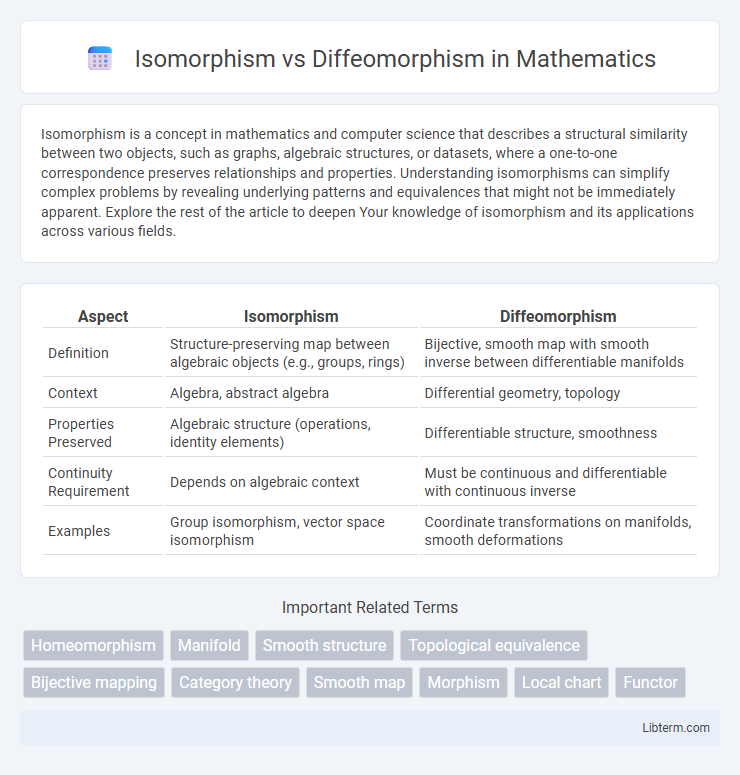Isomorphism is a concept in mathematics and computer science that describes a structural similarity between two objects, such as graphs, algebraic structures, or datasets, where a one-to-one correspondence preserves relationships and properties. Understanding isomorphisms can simplify complex problems by revealing underlying patterns and equivalences that might not be immediately apparent. Explore the rest of the article to deepen Your knowledge of isomorphism and its applications across various fields.
Table of Comparison
| Aspect | Isomorphism | Diffeomorphism |
|---|---|---|
| Definition | Structure-preserving map between algebraic objects (e.g., groups, rings) | Bijective, smooth map with smooth inverse between differentiable manifolds |
| Context | Algebra, abstract algebra | Differential geometry, topology |
| Properties Preserved | Algebraic structure (operations, identity elements) | Differentiable structure, smoothness |
| Continuity Requirement | Depends on algebraic context | Must be continuous and differentiable with continuous inverse |
| Examples | Group isomorphism, vector space isomorphism | Coordinate transformations on manifolds, smooth deformations |
Introduction to Isomorphism and Diffeomorphism
Isomorphism refers to a structure-preserving map between two algebraic systems, such as groups, rings, or vector spaces, ensuring they are fundamentally identical in terms of operations and relations. Diffeomorphism is a smooth, bijective map with a smooth inverse between differentiable manifolds, preserving the manifold's smooth structure and geometry. Both concepts highlight equivalence but in different mathematical contexts--algebraic structures for isomorphisms and smooth manifolds for diffeomorphisms.
Defining Isomorphism: Foundations and Examples
Isomorphism is a fundamental concept in mathematics that signifies a structural equivalence between two objects, where a bijective mapping preserves operations and relations, ensuring they are fundamentally the same in a given context. In algebra, an isomorphism between groups, rings, or vector spaces guarantees that corresponding elements interact identically under the defined operations, exemplified by matrix isomorphisms preserving linear transformations. This foundational idea enables mathematicians to classify objects up to isomorphism, simplifying complex structures by demonstrating their underlying sameness despite superficial differences.
Defining Diffeomorphism: Key Concepts
Diffeomorphism is a smooth, invertible mapping between differentiable manifolds that preserves the structure of the manifolds through smooth functions with smooth inverses. It is a key concept in differential geometry ensuring that two manifolds are "differentially equivalent," meaning they share the same differentiable structure. Unlike isomorphisms in algebraic contexts, diffeomorphisms require compatibility with the smooth structure, making them fundamental in understanding manifold equivalence in calculus and topology.
Core Differences: Isomorphism vs Diffeomorphism
Isomorphism refers to a structure-preserving map between mathematical objects that indicates they are fundamentally the same in terms of their algebraic properties, while diffeomorphism is a smooth, invertible map between differentiable manifolds preserving the differentiable structure. The core difference lies in their domains and structures: isomorphisms apply broadly in algebraic contexts such as groups, rings, or vector spaces, whereas diffeomorphisms specifically concern smooth manifolds and differentiability. This distinction highlights that isomorphisms guarantee algebraic equivalence, whereas diffeomorphisms ensure equivalence under smooth transformations, crucial in differential geometry.
Mathematical Contexts: Where Each Term Applies
Isomorphism primarily applies in algebraic structures such as groups, rings, and vector spaces, where it denotes a bijective map preserving operations and structure. Diffeomorphism is used in differential geometry and topology, referring to a smooth, invertible map between differentiable manifolds that maintains differentiable structure. While isomorphisms emphasize algebraic equivalence, diffeomorphisms address smooth equivalence, crucial for understanding manifold structures and smooth transformations.
Structural Preservation: Algebraic vs. Smooth Structures
Isomorphisms preserve algebraic structures by maintaining operations such as addition and multiplication in algebraic objects like groups, rings, and vector spaces. Diffeomorphisms preserve smooth structures by ensuring smooth bijections with smooth inverses between differentiable manifolds, maintaining differentiability and geometric properties. While isomorphisms focus on algebraic equivalence, diffeomorphisms emphasize smooth geometric equivalence, crucial in differential topology.
Topological vs. Smooth Manifolds
Isomorphism in topology refers to a homeomorphism, a continuous bijection with a continuous inverse, which classifies topological manifolds up to topological equivalence. Diffeomorphism is a stronger condition for smooth manifolds, requiring a smooth bijection with a smooth inverse that preserves differentiable structures. While every diffeomorphism induces a homeomorphism, not all homeomorphisms are diffeomorphisms, reflecting the subtler distinctions between topological and smooth manifold categories.
Real-World Applications and Implications
Isomorphisms enable the comparison of algebraic structures by preserving operations, crucial in cryptography for secure communication protocols. Diffeomorphisms provide smooth, invertible mappings between manifolds, essential in physics for modeling spacetime in general relativity and robotics for motion planning. Understanding these mappings facilitates advancements in data analysis, computer graphics, and complex system simulations.
Visualizing Isomorphisms and Diffeomorphisms
Isomorphisms represent structure-preserving mappings between algebraic objects that maintain operations exactly, allowing visualization as perfect symmetry or exact duplication of patterns. Diffeomorphisms are smooth, invertible maps between differentiable manifolds with smooth inverses, visualized as continuous, distortion-free deformations that preserve differentiable structure without tearing or folding. Visualizing isomorphisms highlights algebraic equivalences like graph or group isomorphisms as identical connectivity or relational patterns, while diffeomorphisms are best conceived as elastic transformations of geometric shapes maintaining differentiability and smoothness of the manifold.
Conclusion: Choosing the Right Concept
Choosing between isomorphism and diffeomorphism depends on the mathematical context and the structure under consideration. Isomorphisms preserve algebraic structures such as groups or vector spaces, making them ideal for discrete or algebraic frameworks, while diffeomorphisms maintain smooth structures between differentiable manifolds, essential in differential geometry and topology. Understanding the nature of the objects and the properties to be preserved guides the selection of the appropriate concept for rigorous analysis or practical application.
Isomorphism Infographic

 libterm.com
libterm.com